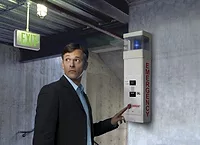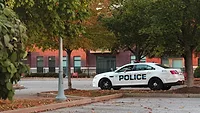Integrated Solutions
Parking safety: Lighting best practices
Lighting choices are a critical component to parking safety best practices, but choosing appropriate lighting means juggling ROI, energy savings and reliability.

tifonimages / iStock / Getty Images Plus via Getty Images
A vehicle pulls down the ramp, and the occupancy-based LED lighting advances with the vehicle as it moves forward into an eerily dark garage. The vehicle curves around a ramp as it moves to the floor below, passing an elevator vestibule, a stairwell entrance, and finally coming to rest after being parked at the far end of the garage.
The driver exits the car and walks toward the elevator vestibule, observing the previously illuminated path receding. As the person continues walking down the vehicle aisleway toward the elevator vestibule, the LED lights are malfunctioning — the respective LED array has partially failed, and the previous lumen output has decreased significantly. Lights on the path to the elevator vestibule do not activate, as the unmaintained motion sensors have become obfuscated by vehicle exhaust soot.
Unknown to the traveler, an aggressor lies waiting in the garage, where inadequate lighting has created dark shadows and a lack of uniformity.
Safety and security professionals know that parking garages are a prevalent location for assaults and other security incidents. While security stakeholders can implement a number of security technologies and best practices to reduce risk and threats within parking garages, an important focus should be placed on lighting.
Maximizing occupant safety and addressing security gaps with lighting is one of the imperative layers of any parking garage security program, but current technology challenges do exist.
The Pros & Cons of LED Lighting
The biggest benefit of LED lighting is the bright white light, instantaneous re-strike time and minimal energy draw, unlike its previously preferred predecessor, HID light. Unlike HID lighting, LED modules will indefinitely continue to diminish in performance in what is referred to as lumen drift.
Lumen drift is indistinguishable beyond lighting measurement because it is gradual compared to an incandescent/filament lighting type failure. LED can save energy through motion sensing-based control, which is impossible with any other type of light source except incandescent, which offers an immediate re-strike.
LED lighting supposedly has a longer rated life than traditional lighting, but other failure points are likely. For example, with LED lighting, the DC driver and the LEDs can have limited life expectancies. The promise of life expectancy is incumbent on the manufacturer; sometimes, improper design and installation can negatively affect an LED’s expected life.
The Business Decision
There is certainly an opportunity for energy savings with LED lighting and Leadership in Energy and Environmental Design (LEED) certification, but at what cost? The annual return on investment (ROI) for energy efficiency provided will pale to that of a premise liability lawsuit if long-term lighting failures are present within a parking garage or location.
Lighting can be a large deterrent to crime and should, therefore, be given significant weight when determining parking garage and parking lot safety best practices for any organization.
Lighting Considerations and Best Practices in Design
LEED calculations for parking garages must include both interior and exterior lighting, regardless of whether the spaces are conditioned or unconditioned. Uniform Building Code requirements require a lighting system to provide emergency illumination for egress with at least 10 lux illumination along the egress path.
An egress path in a parking garage delineates the area from any parking space to an exit or stairway/elevator leading to an exit. The Illumination Engineering Society North America (IESNA)-recommended light levels for parking garages to be 10 lux and not more than a 10:1 max-to-min illuminance ratio (uniformity).
Preventative Maintenance
While calculating and designing parking garage lighting to industry standards is important, it’s certainly not the only best practice for parking safety. Preventative maintenance and lighting feature sets are important considerations for security professionals when it comes to parking area lighting.
Vehicle exhaust soot and environmental conditions easily render occupancy and motion devices inoperative over time. In addition, lumen drift is a genuine concern, and any technological monitoring must be addressed in a preventative maintenance schedule where lighting devices are inspected, cleaned and tested to function as expected. Inspection may require light metering and/or physical inspection of the LED array.
In short, lights should be tested as frequently as possible by walking through the parking area and noting any areas where lights do not react to occupancy motion or where dark spots are apparent.
Lighting Technology and Integrations
While technology considerations and preventative maintenance are best practices for any parking lot safety program, today’s lighting technology encompasses a number of challenges that security and safety stakeholders must overcome for parking lot safety.
Today, many of the occupancy and motion devices used within parking garages can be damaged or tricked by bad actors simply standing motionless.
Using thermal or radar video devices to control lighting can make it more difficult for assailants to avoid detection. A radar device, for example, can transmit a signal of electromagnetic waves in a safe frequency spectrum and collect data from the signal reflected back from objects. Radar can classify objects detected as human or vehicle and trigger the appropriate response. A radar can also determine the speed at which an object is moving.
Thermal imagers, which measure and map the infrared energy (IR) all objects emit, are more costly than radar, but a thermal camera can detect the motionless presence of a person or vehicle.
Security cameras alone can be beneficial, but integrating lighting controls with video and access control systems can further help security professionals. For example, thermal cameras could be used to locate open parking spaces and become a valuable parking management resource.
Integration with an access control system can increase lighting levels when a door or gate is opened and even call an elevator to the garage level where a person is parked to reduce time spent waiting in elevator lobbies. With radar, parking garage stakeholders can also detect the speed a vehicle is traveling and can even tag specific vehicles for identification if any parking garage violations occur.
In short, when it comes to parking lot safety, focusing only on LEED certification when it comes to lighting could backfire if inappropriate lighting choices create an unsafe environment. Though the energy savings realized by the reduction in energy usage can be as much as 80% and controlling the lights with occupancy or motion devices can multiply those savings further, the potential costs an organization can incur to reputation and litigation of a premise liability suit could easily negate those monetary savings.
It’s imperative that security and safety stakeholders design parking environments with the most important emphasis on safety, reliability and situational awareness over energy cost savings.
Looking for a reprint of this article?
From high-res PDFs to custom plaques, order your copy today!









